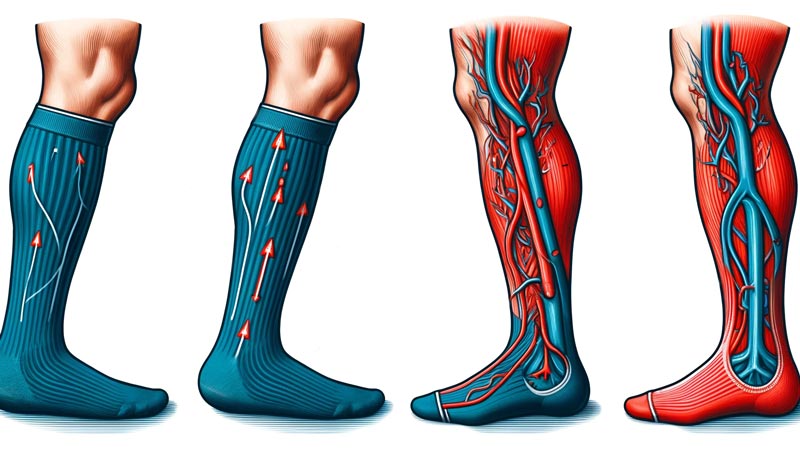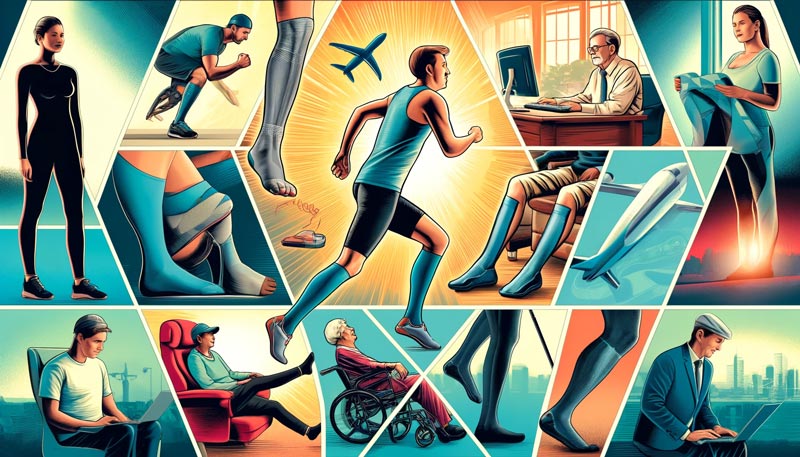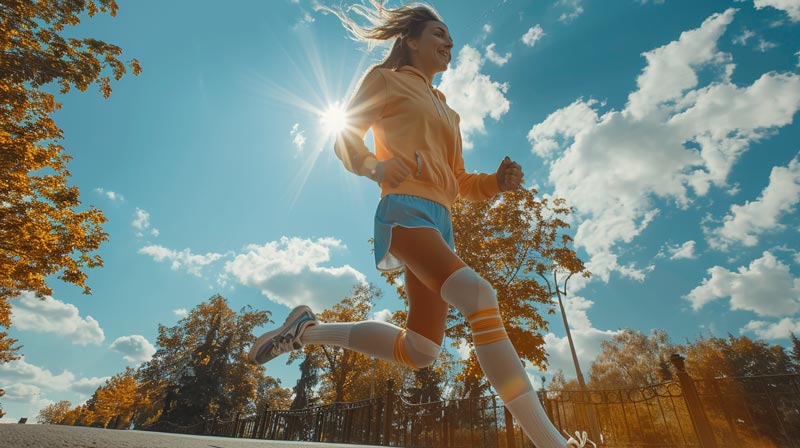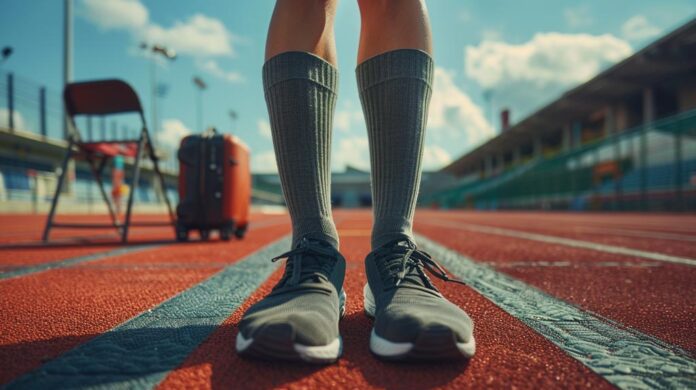The benefits of compression socks have garnered attention from athletes and fitness enthusiasts alike, making them a popular choice for improving performance and recovery.
As a former athlete, my first encounter with compression socks dates back to the early 2000s at Loughborough University. I witnessed the legendary Paula Radcliffe, the GOAT of distance running, using them in training. Initially, I perceived them as a mere fashion statement, needing more understanding of their potential benefits for sprinters like me.
It wasn’t until I observed other elite athletes, such as Australian 400-meter hurdler Jana Pittman and the renowned Jo Pavey, consistently incorporating compression socks into their training sessions and races, that I began to grasp their significance.
Compression socks offer many benefits that extend beyond the realm of elite athletics or sports. They have the potential to improve circulation, reduce muscle soreness, and alleviate fatigue, making them a valuable tool for individuals of all ages and fitness levels. Research suggests that compression socks worn below the knee are a popular, low-cost strategy to improve circulation in clinical populations and, more recently, to enhance athletic performance and/or recovery from exercise in athletic populations.
In the following sections, we will explore the mechanics behind how compression socks work and examine the specific benefits of compression socks they offer. The advantages of incorporating compression socks into your routine are numerous, from improved circulation to faster recovery. Whether you’re an athlete striving for peak performance or maintaining healthy legs and feet, compression socks have something to offer.
As we progress through this blog post, we will uncover the science behind compression socks and provide practical insights on integrating them into your lifestyle. Get ready to discover how this seemingly simple accessory can revolutionise your approach to exercise, recovery, and overall well-being.

How Compression Socks Work
Compression socks apply graduated pressure to the lower legs, with the highest pressure at the ankle gradually decreasing up the calf. This pressure gradient helps to improve blood flow and reduce swelling in the legs. The benefits of compression socks lie in their ability to assist the body’s natural mechanisms for returning blood to the heart.
By compressing the lower leg, these socks support the action of the skeletal muscle pump, which helps to move blood through the veins. When muscles contract, they squeeze the veins and push blood towards the heart. Compression socks enhance this process by providing external pressure, reducing the diameter of the veins and improving valve competence. The compression provided by the socks is critical to unlocking the benefits of compression socks.
In addition to aiding venous return, compression socks may also improve proprioceptive information. The pressure and texture of the socks stimulate receptors in the skin and soft tissue, providing enhanced sensory feedback to the brain. This increased proprioceptive input can improve balance and stability, particularly in older individuals or those with sensory deficits.
Compression socks improve circulation and reduce blood pooling in the lower legs, helping alleviate fatigue, swelling, and discomfort. They benefit individuals who spend long standing or sitting and athletes looking to improve performance and recovery.
Key Benefits of Compression Socks
Compression socks offer many benefits that can positively impact individuals from all walks of life. Compression socks can provide numerous advantages, whether you’re an athlete looking to enhance your performance, a professional seeking relief from long hours of standing, or someone recovering from an injury.
The benefits of compression socks are rooted in their ability to improve circulation, reduce swelling, and support the muscles and joints of the lower legs. By applying graduated pressure to the lower legs, compression socks help to promote efficient blood flow and reduce the accumulation of fluid in the feet and ankles.
This improved circulation can lead to positive outcomes, from increased energy levels to faster recovery after exercise. The benefits of compression socks extend beyond just physical improvements, as they can also provide mental and emotional benefits such as reduced feelings of fatigue and increased overall well-being.
Here are some of the critical benefits of compression socks:
- Improved Circulation: Compression socks assist the body’s natural process of returning blood to the heart by applying graduated pressure to the lower legs. This pressure gradient helps to reduce the diameter of the veins and improve valve competence, leading to enhanced venous return and increased oxygenation of the muscles.
- Enhanced Performance: Studies have shown that wearing compression socks during exercise can improve running economy, reduce muscle oscillation, and better remove metabolites. These factors can contribute to enhanced athletic performance and reduced fatigue during extended periods of activity.
- Faster Recovery: Compression socks have been found to aid in exercise recovery by reducing muscle soreness and improving various recovery markers in the hours and days following physical activity. Compression socks can help athletes bounce back more quickly after intense training sessions or competitions by promoting efficient circulation and reducing inflammation.
Reduced Swelling and Inflammation: The graduated pressure provided by compression socks helps to prevent the pooling of blood and fluid in the lower legs, which can lead to swelling and discomfort. By reducing swelling and inflammation, compression socks can help to alleviate pain and promote overall leg health, particularly for individuals who spend long periods standing or sitting.

Who Should Use Compression Socks?
The benefits of compression socks are varied and appeal to a wide range of individuals, from athletes to those with medical conditions. Here’s a closer look at who should consider incorporating compression socks into their daily routine:
- Athletes:
- Runners, cyclists, and other endurance athletes can benefit from wearing compression socks during training and competition to improve performance and reduce muscle fatigue.
- Compression socks can also aid post-exercise recovery by promoting efficient blood flow and reducing muscle soreness.
- Individuals with Medical Conditions:
- People with chronic venous insufficiency, varicose veins, or a history of deep vein thrombosis (DVT) can benefit from wearing compression socks to manage symptoms and prevent complications.
- Diabetic patients may find compression socks helpful in promoting circulation and reducing the risk of foot ulcers and other complications.
- People with Sedentary Lifestyles:
- Those who spend long hours sitting or standing, such as office workers or retail employees, can benefit from wearing compression socks to prevent blood from pooling in the lower legs and reduce the risk of developing varicose veins or DVT.
- Gamers:
- Prolonged gaming sessions can increase the risk of venous thromboembolism, a condition known as “e-thrombosis.” Compression socks may mitigate this risk by promoting better circulation in the lower legs during extended periods of sitting.
- COVID-19 Patients and Survivors:
- COVID-19 infection increases the risk of venous thromboembolism (VTE), and compression socks may be recommended as part of a comprehensive prevention strategy.
- Those who have recovered from COVID-19 should exercise caution when travelling long distances and consider wearing compression socks to reduce the risk of VTE.
- Travelers:
- Long-haul flights (lasting 7 hours or more) can increase the risk of developing DVT, especially for those with additional risk factors such as obesity, age, or a history of VTE.
- Wearing compression socks during long flights can help prevent the development of DVT and reduce leg swelling and discomfort.
- Pregnant Women:
- Pregnancy increases the risk of developing VTE, and compression socks can be an effective way to manage this risk and alleviate leg discomfort.
Compression socks can offer significant benefits to a diverse group of individuals, helping to improve circulation, reduce the risk of complications, and enhance overall comfort and well-being.
Choosing the Right Compression Socks
Selecting the right pair of compression socks is crucial to ensure the benefits of compression socks are maximised. With various types of compression socks available on the market, it’s essential to understand their differences and how to choose the best pair for your needs.
Types of Compression Socks:
- Clinical Compression Socks: These socks are designed for medical purposes and typically provide higher compression levels, ranging from 20-30 mmHg or more. Healthcare professionals often prescribe them to manage conditions such as chronic venous insufficiency, deep vein thrombosis, or post-surgical recovery.
- Non-Clinical Compression Socks: Non-clinical compression socks, also known as sports compression socks, usually offer lower levels of compression, ranging from 8-15 mmHg. These socks are popular among athletes and fitness enthusiasts to improve performance, reduce muscle fatigue, and aid recovery.
- Commercial Socks: Commercial compression socks are widely available and often provide a range of compression levels. These socks suit everyday wear and can help alleviate leg discomfort, swelling, and fatigue associated with prolonged sitting or standing.
How to Select the Right Pair:
- Determine Your Need: Consider why you want to wear compression socks. Are you managing a medical condition, looking to enhance athletic performance, or seeking relief from leg discomfort? Understanding your primary reason will help you choose the appropriate type and compression level.
- Consider the Compression Level: Different compression levels are suitable for different needs. Consult your doctor for medical conditions to determine the appropriate compression level. A lower compression level (8-15 mmHg) may be sufficient for sports and everyday wear.
- Ensure Proper Fit: Compression socks should fit snugly but be tight enough. Measure your leg circumference at the ankle and calf to select the correct size. A well-fitted sock will provide consistent compression without causing discomfort or restricting circulation.
- Choose the Right Length: Compression socks come in various lengths, such as knee-high, thigh-high, and waist-high. Knee-high socks are the most common and suitable for most purposes, but consider your specific needs and preferences when selecting the length.
- Look for Quality Materials: Opt for compression socks made from high-quality, breathable materials like nylon, spandex, or merino wool. These materials will help wick away moisture, prevent odours, and provide comfort during extended wear.
- Graduated Compression: Graduated compression socks provide the highest level of compression at the ankle and gradually decrease up the leg. This design promotes better blood flow and helps prevent blood pooling in the lower legs.
Suppose you consider these factors and understand the different compression socks available. Then, you can select the right pair to suit your needs and experience the numerous benefits of compression socks.

Embrace the Benefits of Compression Socks Today
Throughout this blog post, we have explored the numerous benefits of compression socks and how they can positively impact various aspects of our lives. Compression socks have proven valuable in promoting better health and well-being. From athletes striving for peak performance to individuals managing medical conditions or seeking relief from everyday discomforts.
We have explored the science behind how compression socks work. Uncovering how they improve circulation, reduce swelling, and support the muscles and joints of the lower legs. Compression socks assist the body’s natural processes by applying graduated pressure, leading to a range of positive outcomes, such as enhanced athletic performance, faster recovery, and reduced risk of complications.
Moreover, we have seen how compression socks can benefit a wide range of individuals, including athletes, those with medical conditions, sedentary lifestyles, gamers, COVID-19 patients and survivors, travellers, and pregnant women. Their versatility makes them an accessible and effective solution for many people seeking to improve their health and comfort.
Choosing the right pair of compression socks is crucial to maximising their benefits. You can select a pair that best suits your needs and preferences by understanding the different types of compression socks available and considering factors such as compression level, fit, length, and material.
As we conclude the benefits of compression socks, I hope the information provided has been insightful and empowering. Whether you are an athlete looking to take your performance to the next level, an individual seeking relief from medical conditions, or simply someone who wants to maintain healthy legs and feet, embracing the benefits of compression socks can be a step towards a more comfortable and active lifestyle.
Incorporating compression socks into your daily routine can be an affordable and practical strategy to support your health and well-being. As you go about your day, whether engaging in physical activity, travelling, or simply going about your daily tasks, consider how compression socks enhance your experience and contribute to your overall vitality.
So, if you haven’t already, I encourage you to explore the world of compression socks and discover how they can make a positive difference. Embrace the benefits of compression socks today, and take a proactive step towards better health, comfort, and performance.
Sources
- Agu O, Baker D, Seifalian AM. Effect of graduated compression stockings on limb oxygenation and venous function during exercise in patients with venous insufficiency. Vascular. 2004;12:69–76.
- Beasley R, Heuser P, Raymond N. SIT (seated immobility thromboembolism) syndrome: a 21st century lifestyle hazard. N Z Med J. 2005;118(1212):U1376.
- Belcaro G, Cesarone MR, Nicolaides AN, et al. Prevention of venous thrombosis with elastic stockings during long-haul flights: the LONFLIT 5 JAP study. Clin Appl Thromb Hemost. 2003;9(3):197–201.
- Blazek C, Amsler F, Blaettler W, Keo HH, Baumgartner I, Willenberg T. Compression hosiery for occupational leg symptoms and leg volume: a randomised crossover trial in a cohort of hairdressers. 2013;28(5):239–247.
- Bringard A., Perrey S., Belluye N. (2005). Aerobic energy cost and sensation responses during submaximal running exercise – positive effects of wearing compression tights. Int. J. Sports Med. 27, 373–378. 10.1055/s-2005-865718.
- Chandra D, Parisini E, Mozaffarian D. Meta-analysis: travel and risk for venous thromboembolism. Ann Intern Med. 2009;151(3):180–190.
- da Silva CA, Helal L, da Silva RP, Belli KC, Umpierre D, Stein R. Association of Lower Limb Compression Garments During High-Intensity Exercise with Performance and Physiological Responses: A Systematic Review and Meta-analysis. Sports Med. 2018 Aug;48(8):1859-1873.
- Engel FA, Holmberg HC, Sperlich B. Is there evidence that runners can benefit from wearing compression clothing? Sports Med. 2016;46(12):1939–1952.
- Hill J, Howatson G, van Someren K, Leeder J, Pedlar C. Compression garments and recovery from exercise-induced muscle damage: A meta-analysis. Br J Sports Med. 2014;48(18):1340–1346.
- Jacobsen AF, Skjeldestad FE, Sandset PM. Ante- and postnatal risk factors of venous thrombosis: a hospital-based case-control study. J Thromb Haemost. 2008;6(6):905–912.
- Liu R, Lao TT, Kwok YL, Li Y, Ying MTC. Effects of graduated compression stockings with different pressure profiles on lower-limb venous structures and haemodynamics. Adv Ther. 2008;25:465-7-8.
- Nopp S, Moik F, Jilma B, et al. Risk of venous thromboembolism in patients with COVID-19: A systematic review and meta-analysis. Res Pract Thromb Haemost. 2020;4(7):1178–1191.
- Orth D, Davids K, Wheat J, Seifert L, Liukkonen J, Jaakkola T, et al. The role of textured material in supporting perceptual-motor functions. PLoS One. 2013;8(4):e60349.
- Parker S, Mahomed O. Hypoxia and thrombosis in COVID-19: new considerations for air passengers. J Travel Med. 2020;27(8).
- Wu SC, Crews RT, Skratsky M, Overstreet J, Yalla SV, Winder M, Ortiz J, Andersen CA. Control of lower extremity edema in patients with diabetes: Double blind randomised controlled trial assessing the efficacy of mild compression diabetic socks. Diabetes Res Clin Pract. 2017;127:35–43.



